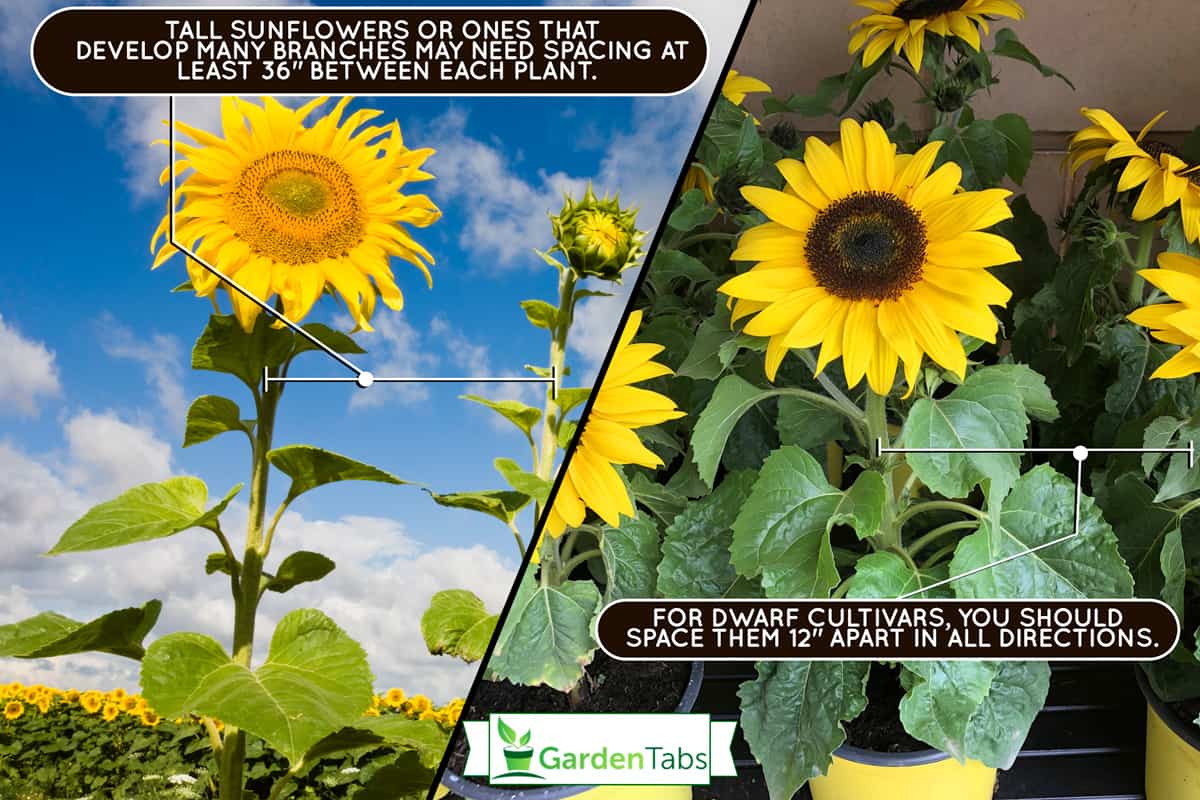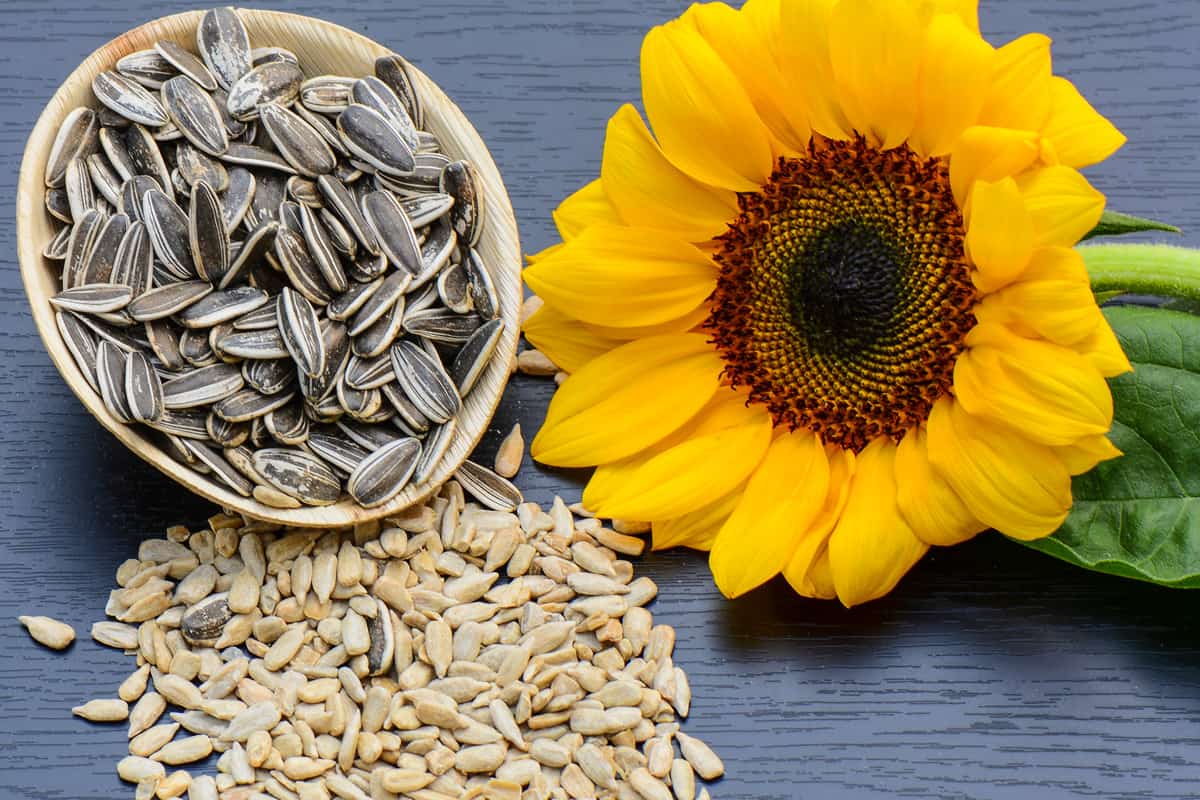The beautiful and bright blooms of sunflowers can catch anyone's attention. One fantastic fact about sunflowers is that their flower heads rotate daily to face the sun. And to allow them to turn comfortably, you must consider how far apart they should be from each other. Worry no more since we already got the answers for you!
For dwarf cultivars, you should space them 12" apart in all directions. On the other hand, tall sunflowers or ones that develop many branches may need spacing at least 36" between each plant.
Did you know that sunflowers are fast-growing plants? If you want to know more about them, it would be best to read on. We have gathered much information and want to share it with you so that you can grow a healthy and bright sunflower. Let's delve into the details!

How Far Apart Should You Plant Sunflowers

Sunflowers are annual plants, which means they only have a short lifespan. They are rapid growers ready to bloom just 80 to 120 days after sowing their seeds.
It would be best to plant them in the spring when the soil temperature in your garden has reached at least 55 degrees Fahrenheit.
If you plan to plant the tall cultivars of sunflowers, we suggest planting them 36" apart since they can develop multiple branches as they grow. And if you opt for the dwarf varieties, 12" spacing would suffice.
What Are The Top Picks Sunflowers To Plant

You may not know this, but there are around 70 unique sunflower species. The shortest sunflowers are just about 20" tall. On the other hand, the tallest varieties can reach heights of more than 120" tall. Some of the best types are as follows.
Giant Sunflower Variety
You can go for the Russian Giant Sunflower if you want golden-yellow but bright blooms. It can reach a height of 120".
Tall Sunflower Variety
- Velvet Queen Sunflower grows about 72" tall and has striking, deep red blooms.
- Earth Walker Sunflower grows to 72" and has multicolored flowers. You can see the blooms in yellow, bronze, and orange.
- Red Sun Sunflowers grow to a height of 72". Their blooms are dark red. Also, you'll notice that their centers are nearly black.
- Valentine Sunflower grows to a height of 60". They produce blooms with a buttery yellow color.
Dwarf Sunflowers
- Teddy Bear Sunflowers are around 20" in height and have double, yellow pompom blooms.
- Dwarf Yellow Spray Sunflowers are short, bushy varieties that bloom with bright yellow flowers. They can grow 24" tall.
How To Properly Plant Sunflowers

Before you start the planting process of your sunflowers, prepare the following first:
- Rake
- Trowel
- Pots
- Sunflower seeds
- Clear plastic bags
- Compost
Planting Sunflower Seeds Indoors

It would be best to plant your sunflower seeds indoors in April. And if the danger of frost has passed, we suggest transplanting it outdoors in May.
If you want to grow healthy and bright sunflower blooms, follow the methods below:
- Get the compost and pour it into the pots.
- Sow only a single seed in each jar. Ensure to plant it 1/2 to 1" deep.
- Adequately water the pots. Do not make it too soggy. After that, cover them with plastic bags.
- Try a windowsill that doesn't receive direct sunlight for an excellent, sunny spot to house your potted sunflower plants.
- When the seeds have sprouted, you can take them out of the plastic. In addition, make sure the multipurpose compost stays damp.
- We suggest hardening off the sunflower for two weeks before you transfer it outdoors. You can do this by moving the containers outdoors during the daytime and back indoors at nighttime.
- To prepare an outdoor planting area, remove any weeds and work in plenty of compost or well-rotted manure.
- Plant the sunflowers 18" apart from each other.
- When you're done planting, give it plenty of water.
Planting Sunflower Seeds Outdoors
Another option is to plant sunflower seeds outside or directly to the ground in late May. Here's the procedure:
- Remove any weeds, then cover the area with compost or well-rotted manure.
- We suggest raking the soil until it becomes granular and level.
- The ideal conditions for seed germination include a depth of 1-2", a spacing of 4-6", and enough water.
- Once you notice that your sunflower seeds have germinated, it would be best to thin them up to 18".
Sunflower Cultivation Sites
Soil rich in nutrients and abundant sunlight is necessary conditions for sunflower growth. After those prerequisites have been met, you are free to let your creative juices flow when growing sunflowers.
Grow your masterpieces by planting tiny cultivars in decorative pots. You could line a walkway with sunflowers if you have the room. For maximum effect in the summer, we suggest planting sunflowers in rows around your borders.
Planting Sunflowers For Harvest
If you plant and grow sunflowers because you want to create flower arrangements, you'll want to make sure they grow into bushy plants with many flowers.
Pinch the plant's developing tips to encourage bushy growth and produce fuller sunflowers. As a result, the plants will send forth numerous lateral branches bearing innumerable blooms.
- If you want your sunflowers to grow at their optimum height, pinch off the growing tips when they are 8" tall.
- When dwarf sunflowers reach a height of 4-6", it would be best to prune them severely, allowing them to remain with only two sets of leaves on their stem. To continue the process, wait until the plant has developed another 3-4".
How To Properly Care For Sunflowers

As mentioned, sunlight and properly draining soil are all we need to cultivate sunflowers successfully.
As much as possible, choose a spot away from strong winds that could potentially knock over these tall plants. In addition, clusters of sunflowers may protect one another from the elements by bracing against wind and water.
Gardeners often place stakes around them to maintain tall sunflower types erect correctly. When the sunflower plant is flowering, expect they are cumbersome at the top.
The simplest way to stake sunflowers is to plant them along a fence. You can also hold them upright by using sturdy bamboo stakes. Avoid harming the plant's roots by being gentle when placing the stakes.
Furthermore, we suggest covering your sunflower seeds with screening or row covers. Doing so will protect them from those wild animals and pests that love to feed on your sunflowers. Once your sunflower reaches a height of up to 2", remove the row cover.
Adequate Sunlight
Plant your sunflowers where they receive at least six hours of sunlight daily to maximize blossom production and stem strength. Since their flower heads rotate to face the sun (heliotropic), having them face directly into the light will help them stay upright.
Proper Soil
Sunflowers are not picky when it comes to soil. They can flourish even on dry, arid soils. Soil with a high percentage of organic matter and excellent drainage is ideal.
Enough Watering
Sunflowers can survive in dry climates but won't bloom unless they get regular water. During arid conditions, they frequently cease flowering.
Let the top inch or two of soil dry out between waterings. When the soil around your sunflowers is dry and the plants begin to bend uncontrollably, it indicates that you need to provide ample water.
Checking The Humidity And Temperature
Temperatures between 70 and 78 degrees Fahrenheit are ideal for sunflower cultivation. They can withstand extreme temperatures as long as you can provide enough water when they badly need it.
They may survive in cool areas that receive enough sun or warmth. In addition, they can handle high humidity levels but prefer soil with adequate drainage and enough airflow to not produce problems like root rot.
Feeding Correct Fertilizer
A phosphate and potassium-rich fertilizer is helpful for sunflowers since it gives the plant a gentle cue that it should be producing flowers along its lengthy stalks.
A lack of fertilizer could be acceptable if your soil is naturally fertile. However, if your soil isn't very fertile, you should start using a slow-release fertilizer in the spring.
Moreover, please don't put too much fertilizer on your sunflower plants; doing so can weaken their stalks.
It's A Wrap!

Providing enough space for your sunflower plants will help them produce delicate, healthy, and bright blooms. It is because nothing can hinder them from growing beautifully. Also, providing them with what they need is a must! Growing sunflowers are straightforward, and you just have to be patient enough.
We hope this article helps you with all your questions. If you wish to continue reading, check these related posts out!
Can Sunflowers Grow In Sandy Soil?
How to Grow Mammoth Sunflowers [Garden Guide for Beginners]
Are Sunflowers Deer Resistant? [And How to Protect Your Plants]
